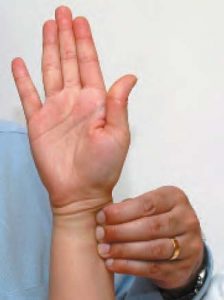Table of Contents
Allen Test Overview
Edgar V. Allen first identified the Allen test for blood flow as a non-invasive measurement of the arterial patency of the hand in patients with thromboangitis obliterans.
Your hand’s blood supply is usually supplied by two arteries: the radial artery and the ulnar artery. Before extracting blood for an arterial blood gas examination, the doctor will ensure that all arteries are open and functioning properly. The Allen test can be used to determine if the blood flow to your hand is natural.
The health professional drawing your blood will apply pressure to the arteries in your wrist for several seconds during the Allen examination. This will cut off the blood supply to your side, causing it to become cold and pale. After that, blood is permitted to circulate into the artery that will not be used to extract the blood sample.
The ulnar artery, which is located on the outside (little finger side) of your wrist, is normally the culprit. The radial artery, which is located on the inner (thumb side) of the wrist, is typically used to collect arterial blood gases.
Clinical History
The Modified Allen Test (MAT) has been created. In Allen’s original examination, the investigator compressed one artery in each hand at the same time, testing both hands simultaneously. The MAT evaluates the adequacy of collateral circulation effectively, but it only tests one hand at a time.
The Allen test is a gold standard for assessing the arterial blood supply of the hand. This test is used to pick patients for radial artery harvestings, such as for coronary artery bypass grafting or forearm flap elevation if intravascular access to the radial artery is scheduled.
The Allen test is part of the diagnostic work-up for upper limb vascular disorders such as thoracic outlet syndrome (TOS). One potential cause of thoracic outlet syndrome, and specifically vascular TOS, is compression of the subclavian artery or vein as it passes through the interscalene triangle by the scalene muscle bodies, which may result in muscular hypertrophy.
Anatomical Knowledge for Allen Test
The hand has a highly complex vascular network that is primarily supplied by the radial and ulnar arteries.
The radial artery passes between the forearm muscles brachioradialis and flexor carpi radialis, splitting at the wrist into a superficial branch that contributes to the superficial palmar arch. The other branch, which forms the deep palmar arch, crosses dorsally deep to the tendons of the anatomic snuffbox.
The ulnar artery runs under the flexor carpi ulnaris of the forearm and joins the Guyon’s canal at the wrist, where it divides into a deep palmar branch and a superficial palmar branch. The superficial palmar branch contributes to the shallow palmar arch, while the deep branch contributes to the deep palmar arch.
Since the radial and ulnar arteries connect by anastomosis (the deep and superficial palmar arch), blood flow to the hand is maintained even though one of the arteries is occluded.
The Procedure of the Allen Test
Palpation at the proximal skin crease of the wrist is used to find the radial artery, which is then squeezed with three digits. The ulnar artery is positioned similarly and then compressed with three digits. The subject is asked to clench and unclench the hand 10 times with both arteries compressed. The hand is then held open to prevent the wrist and fingers from being hyper extended and splayed out. The palm seems to be blanched. The ulnar artery is opened, and the time it takes for the palm, particularly the thumb and thenar eminence, to flush is recorded. The test is considered positive if the capillary refill period is less than 6 seconds. The procedure is then completed by testing the radial artery in a similar manner. For contrast, both hands should be measured.
When performing the Allen test, hyperextension of the hand and large finger separation will result in a false-negative result. This is due to occlusion of the transpalmar arch, and parts of the fingers and palm will remain blanched after the ulnar artery is released. To avoid this, carry out the test with the hand partially open, as defined in Allen’s original work.



Interpretation of the Test
During the Allen test, digital compression is applied to both the ulnar and radial arteries at the proximal wrist crease, causing palmar blanching, accompanied by the release of compression on either artery, causing hyperemia in the non-diseased state. A return of color to the hand within a sufficient time span indicates adequate collateral circulation.
Allen’s test had a sensitivity of 54.5 percent, a precision of 91.7 percent, and a diagnostic accuracy of 78.5 percent based on a cut-off of 6 seconds. Diagnostic accuracy was maximum (79.6 percent) at a cut-off of 5 seconds, with the sensitivity of 75.8 percent and specificity of 81.7 percent; 100 percent sensitivity occurred at a cut-off of 3 seconds, with the specificity of 27 percent and diagnostic accuracy of 52 percent.
A negative test has a predictive value of 0.8 percent and a positive test has a predictive value of just 53%.
| Positive(Normal) | Your hand easily warms up and returns to its original colour. This ensures that only one artery would be sufficient to supply blood to your hand and fingers. |
| Negative(Abnormal) | Your hand is now pale and cold. This means that one artery is insufficient to provide blood to your hand and fingers. This hand’s artery would not be used to absorb blood. |
If the hand remains pale and cold, the Allen test will be done on the opposite hand. If the other hand is still pale, blood is most likely being drawn from another artery, typically in the groin or elbow crease.
Special Hand Tests
Allen Test
Elevate the hand and then use digital pressure to obstruct the radial and ulnar arteries. Make a fist multiple times with the patient. The tips of your fingers should turn pale. Release each artery one at a time and watch the color return.
Clinical Significance
The radial and ulnar arteries, as well as the arcade between them, are used to assess the adequacy of blood supply to the hand.
Tinel’s Test
Tap on the nerve you want to evaluate. Tingling may be an indication of nerve compression.
Clinical Significance
Detects the compression of a peripheral nerve.
Phalen’s Test
Extend the elbows and position the wrist in full flexion.
Clinical Significance
Paraesthesia is caused by medial nerve compression.
Froment’s sign
Suggest the patient hold a sheet of paper between his or her index finger and thumb on both hands. Take a similar grip on the paper. As you try to take the paper away from the patient, ask him or her to resist.
Clinical Significance
A positive test indicated by flexion of the thumb interphalangeal joint indicates weakness of the ulnar nerve-supplied adductor pollicis muscle. The thumb posture is explained by the recruitment of the median nerve-innervated flexor pollicis brevis.
Summary of the Allen Test
The Allen test (AT) is a method of determining collateral blood flow to the hands. The radial artery can be easily felt. The inability to palpate the ulnar artery necessitates this examination. Since the ulnar artery cannot be palpated, its patency and, as a result, collateral circulation of the hand cannot be verified. If the radial artery must be cannulated or catheterized and there is a chance of thrombosis, the Allen test will help ensure that the hand can retain enough blood flow through the ulnar artery and collaterals even if the radial artery becomes occluded. A positive Allen test indicates that the patient does not have an adequate dual blood supply to the hand, which is a contraindication to catheterization, radial artery removal, or any procedure that may result in vessel occlusion. This activity goes over the Allen test for evaluating the ulnar artery and addresses the roles of laboratory technicians, respiratory therapists, nurses, and clinicians in conducting the test.
Proper Indication
The radial artery can be easily felt. The inability to palpate the ulnar artery necessitates this examination. Since the ulnar artery cannot be palpated, its patency and, as a result, collateral circulation of the hand cannot be verified. If the radial artery must be cannulated or catheterized and there is a chance of thrombosis, the Allen test will help ensure that the hand can retain enough blood flow through the ulnar artery and collaterals even if the radial artery becomes occluded. A positive Allen test indicates that the patient may not have a sufficient dual blood supply to the side, which is a contraindication to catheterization, radial artery removal, or other operation that could result in vessel occlusion.
Procedure
The initial Allen test involves asking the patient to raise both hands above their heads for thirty seconds. This will aid in the removal of blood from the patient’s hands. The patient is then asked to make fists with both hands, and the radial artery is occluded simultaneously on both hands. The patient then quickly opens both hands, and the examiner compares the color of both palms. When the blood from the collateral flow returns, the initial pallor should be replaced by the hand’s natural erythematous colour. The examination is then repeated, but this time the ulnar arteries are occluded rather than the radial arteries. The amount of time it takes for the usual color to return indicates the amount of collateral blood flow. When both hands return to normal color after occlusion of either artery alone, the test is negative. A positive test would be characterized by constant pallor in the palm, suggesting that there is no collateral blood flow to the hand.
The updated Allen test varies primarily in that it examines both the radial and ulnar arteries on one side before repeating on the other. Traditionally, the patient’s arm is flexed at the elbow with the fist clenched firmly, or the patient is asked to open and close their fist to help maximize the drainage of blood from the hand. The ulnar and radial arteries are then squeezed simultaneously by the provider’s thumbs. The elbow is then stretched to a maximum of 180 degrees, preventing overextension, which could result in a false-positive test. After that, the fist should be unclenched and the palm should be white. The compression is then relieved from the ulnar artery while pressure is maintained over the radial artery. The color should return to the palm within 10 seconds of the compression is released. The test is repeated on the same limb, except this time the radial artery is released first before attempting to compress the ulnar artery.
In a patient with normal patent arteries, the color of the palms should return relatively quickly (within 10 seconds) after either artery is released. If pallor remains in the patient’s palm after he unclenches his fist and one of the arteries is opened, the examination is positive and indicates an occlusion inside the artery that is being released. For example, if the radial artery is squeezed and palmar pallor continues, it means that the ulnar artery’s blood flow is impaired. If the ulnar artery is constricted and palmar pallor continues, the affected blood flow is in the radial artery.
There are additional resources that the provider can use to improve the accuracy of this test. Digital plethysmography, duplex ultrasonography with dynamic monitoring, and pulse oximetry (often with the sensor mounted on the thumb tip) are all techniques that can be used. The most straightforward approach is to use pulse oximetry when conducting the Allen test. Until compression, a pulse oximeter is placed on the forefinger to obtain a baseline saturating and waveform. The provider will then compress both the radial and ulnar arteries until the waveform vanishes and the saturation level reaches zero. The ulnar artery is then relieved of strain. The waveform and saturation are captured. If these values are compatible with the baseline, it indicates that there is adequate collateral flow.
Possible Complications
There are no established complications other than those caused by not performing or performing the procedure incorrectly. In rare cases, radial arterial blood sampling/cannulation, including artery destruction due to clot blocking, puts the hand at risk of ischemia. Individuals who do not have a dual supply are at a much higher risk of ischemia.
Few Last Words About The Allen Test
The Allen test is used to ensure that the hand had collateral circulation. The test can be used to diagnose a variety of conditions characterized by decreased vascular flow to the arm or after hand surgery. If the radial artery is going to be used for arterial punctures for drawing blood gases, cannulation for placement of arterial lines, catheterization, or radial artery harvest for bypass surgeries, it is more generally used to measure collateral flow to the hand via the ulnar artery. Since the radial artery is readily palpable at the bedside, these procedures are usually performed on it. Ischemia distal to the puncture site is one of the threats associated with arterial punctures, which could damage the limb if there is insufficient collateral blood flow. Though ischemia is a rare complication of an arterial puncture, the Allen test is rarely performed in the clinical setting in most patients. There is insufficient evidence to support this test’s accuracy in determining ulnar artery patency and ensuring collateral circulation. Overall, the Allen test has poor sensitivity when it comes to assessing collateral circulation.
Last Updated on February 23, 2022 by Learn From Doctor Team






